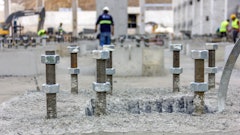

Fischer has launched the FAZ II Plus bolt anchor for construction projects. The new product has a higher assessed tensile load-bearing capacity and material strength than the previous generation. The setting process (M8-M24) does not require cleaning the drill hole.
This anchor is approved for different types of construction materials, including concrete, sand-lime brick and steel fiber-reinforced concrete. A service life of 120 years allows the anchor to be used for various applications.
FAZ II Plus was made for transferring high static and medium dynamic loads in cracked and non-cracked concrete. The anchors are designed for use in sand-lime brick (except for dynamic applications). A European Technical Assessment (ETA) provides added safety.
A general design approval allows anchorages in steel fiber-reinforced concrete with the FAZ II, FAZ II R and FAZ II HCR variants (M6-M24 diameter). Railings, steel beams, pipeline suspensions, cable runs, consoles, facade substructures, wood structures, lifts, conveyor belts, hoists and more can be permanently and safely fastened in various construction materials with the anchor.
The new ETA confirms the application of diameter versions M16-M24 in galvanized and stainless steel materials for dynamic loads. Compared to the previous generation, the tensile load-bearing capacity has increased and a higher strength material is processed. This requires fewer fastening points and anchors per application and project. Regarding applications in seismic regions, the assessment (ETA) covers seismic performance categories C1 and C2, both with and without the FFD filling disc for filling annular gaps, depending on the diameter.
In addition to aborted holes, compliant installation (ETA) can be carried out. The assessment also covers nuts in accordance with ISO and verifies higher fire resistance values than the predecessor product, with temperatures of up to 1,350 °C with a fire duration of up to 180 minutes according to the RWS fire curve.
Users can process the FAZ II Plus bolt anchor in holes created with a hollow, hammer or diamond drill using pre-positioned, push-through or stand-off installation, depending on the situation. The cone bolt is pulled into the expansion clip by tightening the nut, expanding firmly against the wall of the drill hole. The anchor is then able to carry loads immediately. An additional Dynamic Set enables safe installation for dynamic applications.



























